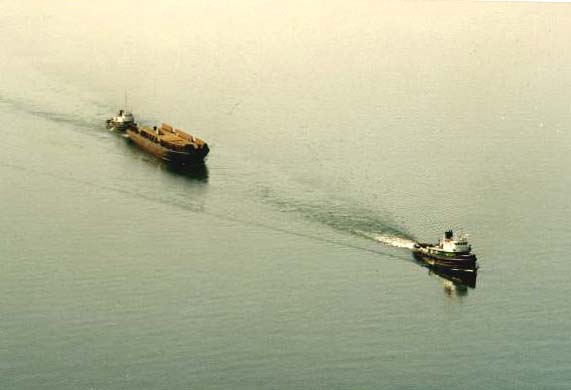
The Midland Photo Mission by Jeff Rogers May 9, 1998

I stretch my time and financial resources as far as I can to cover my interest in ships, flying, photography, and writing. Last month, a friend and I took a Wednesday off to fly his plane out over Lake Michigan to look for the Midland / PM-41 as it was being towed from Muskegon, Michigan to Sturgeon Bay, Wisconsin. I've been following the hull disassembly through this website since last December. I've stayed in contact with Max Hanley along the way, waiting to hear when the hull was to be towed. As the day drew near, Max saw the signs and passed the word along. On Tuesday, April 21, Max confirmed that the tugs were in port, and were preparing to pull the remains of the City of Midland 41 out into Lake Michigan.
Tim Gorski and I flew out of Appleton, about 40 miles west of Manitowoc, at 8:50am on April 22. Tim's plane carries enough fuel for about four hours of flight time. We planned to arrive in our chosen search area, the shore between Kewaunee and Sturgeon Bay, between 9:30 and 10:00. We headed east to Lake Michigan, then turned north along the coast. The sky was hazy at first but the air cleared as we neared water. Through my binoculars I scanned the surface as far out as I could see. There were several commercial fishing vessels, some pleasure craft, and some industrial-looking barges floating about here and there, but I could see no trace of anything resembling a 400 foot hull being towed by tug boats.
This was my first experience at searching over water. As Tim put it, while holding out both hands with palms up: "Needle." (lifting right hand slightly) "Haystack." (dumping right hand into left hand). "Ready? Go!" We talked through the intercom as we flew, imagining together what it must have been like for World War II pilots flying search missions out over the oceans. This was just a big lake (OK, a REALLY big lake), and we sometimes couldn't see boats that were right below us. The feeling put a new perspective on many of the stories I've read.
We spotted the ship about 10 miles south east of Sturgeon Bay at 10:00. At first it was just a short speck in my binoculars. There appeared to be other vessels in front and behind, but I couldn't be sure. We were perhaps 20 miles away, at 3,000 feet above the water. The shapes became recognizable as boats as we got closer. My cameras were ready.
Tim began a slow descent about 10 miles out. We made our first photo pass at 1,000 feet. Tim flew a wide, right-hand circle while I shot through the window on the right side of the plane. We came around again at a lower altitude. I had two cameras going, one with a 50mm lens, the other with a 135mm lens. I kept switching cameras to get different compositions. All the while, Tim and I were talking over the intercom. It was great having headsets with microphones built in. It made for easy, hands-off communication while we tended to our respective tasks.
Tim put the plane through some steep turns while we maneuvered for position. I'd describe the view I wanted, and give directions on lining up for the shot. We made several passes along the ships' course, first flying straight toward them then turning around to overtake them from astern. At one point I was looking straight down through my side window. All I could see was dark, green water. I could see some ripples on the surface, but the wind was calm and there were no real waves. I had no idea how high we were at that point. Depth perception was lost. I trusted Tim to be flying the plane, and waited for him to level off so I could shoot. About that time, Tim spoke into the intercom in a very matter-of-fact voice. "You realize that if the engine coughs right now, we're going to get wet."
I knew, and I told him so. We had recently discussed unplanned water landings in the vicinity of ships. "Just put it down out in front of them," I answered, "so they have time to stop and pick us up." I didn't welcome the thought of having to land in the water. I continued looking out the window, and willed the engine to keep right on running just the way it was. It did.
We circled the tugs and barge for perhaps fifteen minutes, then climbed back to 3,000 feet to circle the Bay Shipbuilding yard while we waited for the vessels to reach the entrance to the canal. Tim banked around again so I could photograph the yard. We saw two freighters in dry-dock and some smaller boats near by. We could also see the Midland inching closer to the canal. The lead tug had slowed to a crawl while they reeled in the hawser. They seemed to take forever to cover the last mile into the breakwaters. We made two more circles over the barge just as it passed the light house. Then we headed back to Manitowoc airport for fuel and lunch.
The mission was a great success. We got some good photos and had a blast doing it. I plan to visit the shipyard to photograph the barge while it is in dry-dock. I hope to photograph the departure for the trip back to Ludington, if possible. I'll share those pictures with Max so he can put them up for everyone to see.
Your comments are welcome. Send email to shaggy@vbe.com.
Some of Jeff's Photos:
A BIG thanks to Jeff for sharing these photos!